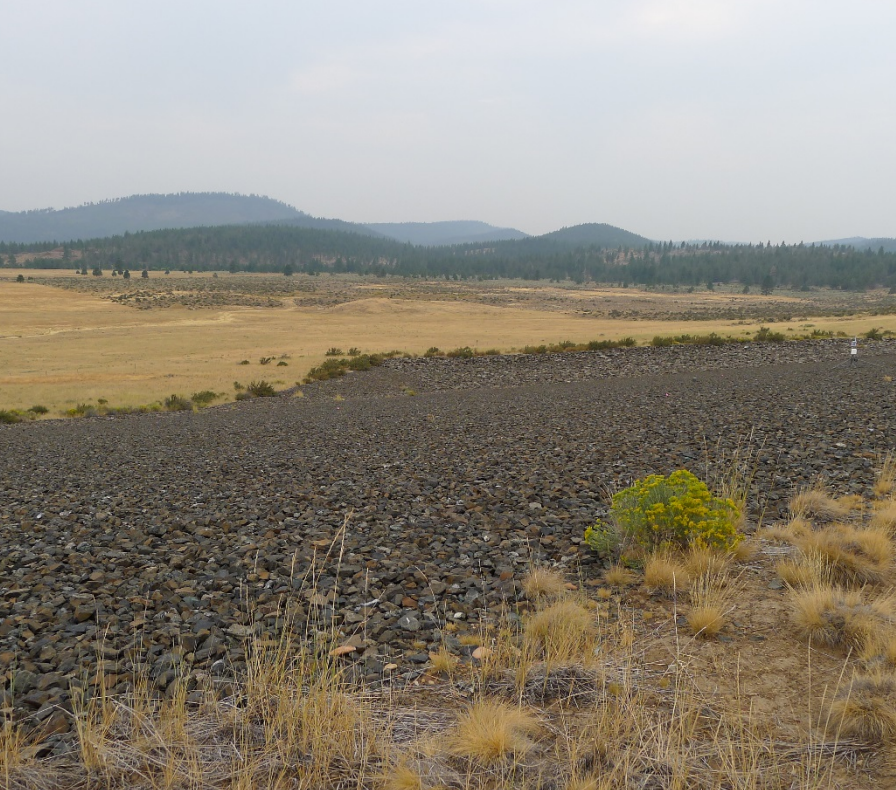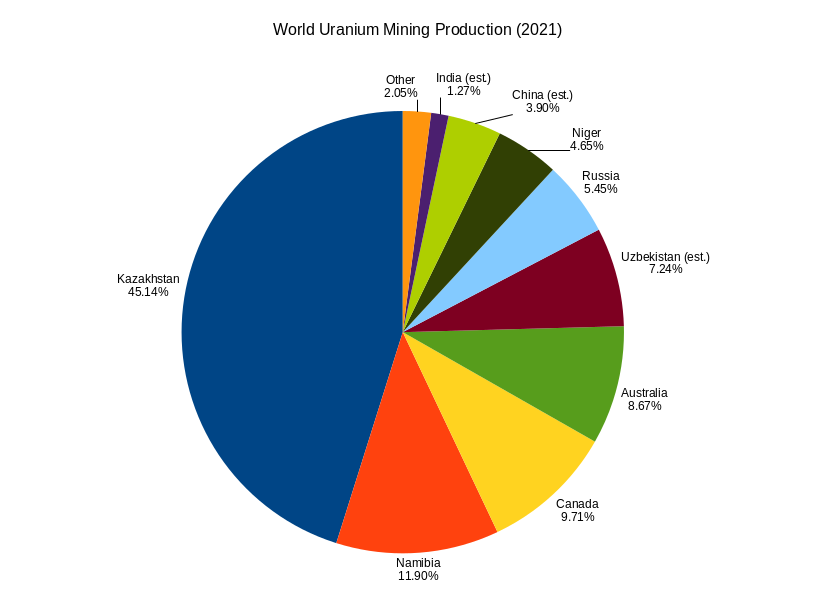|
Lakeview Mining Company
The Lakeview Mining Company was a Uranium mining#Heap leaching, uranium reduction plant north of Lakeview, Oregon, Lakeview, Lake County, Oregon, Lake County, Oregon. The mill began operating in February 1958 and operating until November 1960. The site covered ; of ore were processed, leaving behind large amounts of residual radioactive material. These were moved to an engineered disposal cell in 1986-1988. The plant was built in 1957-1958 for a cost of approximately $3 million, selling the yellow cake to United States Atomic Energy Commission, Atomic Energy Commission. The plant employed approximately 50 workers. Two successful mines were open in the area, Lucky Lass and White King, feeding the Lakeview plant. Seven raffinate ponds across were used for the uranium extraction process, and a uranium tailings pile existed. In 1961 Kerr-McGee purchased the site; it changed hands several times and by 1968 was owned by Atlantic Richfield (ARCO), which began radiation remediation. M ... [...More Info...] [...Related Items...] OR: [Wikipedia] [Google] [Baidu] |
Uranium Mining
Uranium mining is the process of extraction of uranium ore from the ground. Over 50 thousand tons of uranium were produced in 2019. Kazakhstan, Canada, and Australia were the top three uranium producers, respectively, and together account for 68% of world production. Other countries producing more than 1,000 tons per year included Namibia, Niger, Russia, Uzbekistan, the United States, and China. Nearly all of the world's mined uranium is used to power nuclear power plants. Historically uranium was also used in applications such as uranium glass or ferrouranium but those applications have declined due to the radioactivity of uranium and are nowadays mostly supplied with a plentiful cheap supply of depleted uranium which is also used in uranium ammunition. In addition to being cheaper, depleted uranium is also less radioactive due to a lower content of short-lived and than natural uranium. Uranium is mined by in-situ leaching (57% of world production) or by conventional und ... [...More Info...] [...Related Items...] OR: [Wikipedia] [Google] [Baidu] |
Uranium Mill Tailings Radiation Control Act
The Uranium Mill Tailings Radiation Control Act (1978) is a United States environmental law that amended the Atomic Energy Act of 1954 and authorized the Environmental Protection Agency to establish health and environmental standards for the stabilization, restoration, and disposal of uranium mill waste. Title 1 of the Act required the EPA to set environmental protection standards consistent with the Resource Conservation and Recovery Act, including groundwater protection limits; the Department of Energy to implement EPA standards and provide perpetual care for some sites; and the Nuclear Regulatory Commission to review cleanups and license sites to states or the DOE for perpetual care. Title 1 established a uranium mill remedial action program jointly funded by the federal government and the state. Title 1 of the Act also designated 22 inactive uranium mill sites for remediation, resulting in the containment of 40 million cubic yards of low-level radioactive material in UMTRCA Tit ... [...More Info...] [...Related Items...] OR: [Wikipedia] [Google] [Baidu] |
Radioactive Waste
Radioactive waste is a type of hazardous waste that contains radioactive material. Radioactive waste is a result of many activities, including nuclear medicine, nuclear research, nuclear power generation, rare-earth mining, and nuclear weapons reprocessing. The storage and disposal of radioactive waste is regulated by government agencies in order to protect human health and the environment. Radioactive waste is broadly classified into low-level waste (LLW), such as paper, rags, tools, clothing, which contain small amounts of mostly short-lived radioactivity, intermediate-level waste (ILW), which contains higher amounts of radioactivity and requires some shielding, and high-level waste (HLW), which is highly radioactive and hot due to decay heat, so requires cooling and shielding. In nuclear reprocessing plants about 96% of spent nuclear fuel is recycled back into uranium-based and mixed-oxide (MOX) fuels. The residual 4% is minor actinides and fission products the latter of w ... [...More Info...] [...Related Items...] OR: [Wikipedia] [Google] [Baidu] |
Uranium Mines In The United States
Uranium is a chemical element with the Symbol (chemistry), symbol U and atomic number 92. It is a silvery-grey metal in the actinide series of the periodic table. A uranium atom has 92 protons and 92 electrons, of which 6 are valence electrons. Uranium is weakly radioactive decay, radioactive because all isotopes of uranium are unstable; the half-lives of its naturally occurring isotopes range between 159,200 years and 4.5 billion years. The most common isotopes in natural uranium are uranium-238 (which has 146 neutrons and accounts for over 99% of uranium on Earth) and uranium-235 (which has 143 neutrons). Uranium has the highest atomic weight of the primordial nuclide, primordially occurring elements. Its density is about 70% higher than that of lead, and slightly lower than that of gold or tungsten. It occurs naturally in low concentrations of a few Parts-per notation#Parts-per expressions, parts per million in soil, rock and water, and is commercially uranium mining, ext ... [...More Info...] [...Related Items...] OR: [Wikipedia] [Google] [Baidu] |
Center For Land Use Interpretation
The Center for Land Use Interpretation (CLUI) is a non-profit research and education organization involved in exploring, examining, and understanding contemporary landscape issues in the United States. Founded in 1994, the CLUI organizes exhibitions, programs, field trips, and maintains an online archive and database to engage the public's understanding of the man-made landscape, and extent and impacts of human interactions with the surface of the earth. The Center employs a variety of methods to this end, engaging in research, classification, extrapolation, and exhibition. Mission The mission statement of the CLUI is to "increase and diffuse knowledge about how the nation's lands are apportioned, utilized, and perceived." Programs and projects The CLUI also executes exhibitions, research projects, and public programs. The Center's programs and projects cover many types of land uses in the US, including those related to agriculture, energy, industry, mining, communication, ... [...More Info...] [...Related Items...] OR: [Wikipedia] [Google] [Baidu] |
Oregon Department Of Energy
The Oregon Department of Energy (ODOE) was established in 1975 by the Oregon Legislative Assembly as the culmination of recommendations of several task forces and study groups over several years. The state agency helps Oregonians make informed decisions and maintain a resilient and affordable energy system. ODOE advances solutions to shape an equitable clean energy transition The energy transition is the process of downshifting fossil fuels and re-developing whole systems to operate on low carbon energy sources. More generally, an energy transition is a significant structural change in an energy system regarding ..., protect the environment and public health, and responsibly balance energy needs and impacts for current and future generations. ODOE's vision is: "A safe, equitable, clean, and sustainable future." ." Energy in Oregon The largest source of renewable energy in Oregon is hydropower. The majority of Oregon's energy consumption comes from the transportation sector, ... [...More Info...] [...Related Items...] OR: [Wikipedia] [Google] [Baidu] |
Sequoyah Fuels Corporation
Sequoyah Fuels Corporation owned and operated a uranium processing plant near Gore, Oklahoma. The company was created in 1983 as a subsidiary of Kerr-McGee. In 1988 it was sold to General Atomics. Uranium processing plant The plant is located near Gore, Oklahoma, close to the Illinois River and Interstate 40. The plant started construction in 1968 and began operation in 1970. It converted yellowcake uranium into uranium hexafluoride. In 1987 it started converting depleted uranium hexafluoride into depleted uranium tetrafluoride. The plant ceased operation in 1993. After a leak and explosion in 1986 left one worker dead and extreme groundwater and soil contamination across the 600-acre site. See Kerr-McGee article for citations The plant was operated under Kerr-McGee Nuclear Corporation. In 1983 KMNC split into Quivira Mining Corporation and Sequoyah Fuels Corporation. The latter was given control of the plant. In 1988 Sequoyah Fuels Corporation was sold to General Atomics. ... [...More Info...] [...Related Items...] OR: [Wikipedia] [Google] [Baidu] |
Climax Uranium Mill
Climax Uranium Mill is a decommissioned uranium mill near Grand Junction, CO. The mill, which processed vanadium as well as uranium, was incorporated May 11, 1950. It was constructed on city-owned property next to the Colorado River which was once the Grand Junction sugar beet mill. Climax Uranium Company gutted the former sugar beet mill, removing any remaining equipment and stabilizing weak walls, and began uranium and vanadium milling operations. The mill soon grew to be 12 buildings large and processed 2 million tons of ore, mostly for the United States Atomic Energy Commission. The mill caused contamination in an aquifer directly beneath the surface of the site. Mill tailings were allowed to be taken for civilian and construction use in the city which led to many vicinity properties with elevated radiation levels. In 1970, the mill was decommissioned and most of the contaminated materials were brought to the Grand Junction Disposal Site. Some of the leftover tailings used in ... [...More Info...] [...Related Items...] OR: [Wikipedia] [Google] [Baidu] |
Hunter's Hot Springs (Oregon)
Hunters Hot Springs (often stylized as Hunter's Hot Springs) are natural geothermal springs located in Lake County, Oregon, north of Lakeview. The springs are named after Harry Hunter, who bought the springs in 1923. The best known feature within the geothermal area is ''Old Perpetual'', which is Oregon's only continuously erupting geyser. The geyser was formed as a result of a well drilling attempt while Hunter was developing a health resort at the springs. Springs The hot springs were discovered in 1832 by trappers from the Hudson's Bay Company, who noted in their journal that the water was unbearably hot.Birkby, Jeff"Geyser (Hunter's) Hot Spring" ''Touring Washington and Oregon Hot Springs'', Globe Pequot Publishers, Guilford, Connecticut, 2002, p. 120. They are a small group of alkaline thermal springs in Lake County's Goose Lake Valley, north of Lakeview. The temperature of the various springs ranges from . The spring water is alkaline with a high concentration of ... [...More Info...] [...Related Items...] OR: [Wikipedia] [Google] [Baidu] |
National Renewable Energy Laboratory
The National Renewable Energy Laboratory (NREL) in the US specializes in the research and development of renewable energy, energy efficiency, energy systems integration, and sustainable transportation. NREL is a federally funded research and development center sponsored by the Department of Energy and operated by the Alliance for Sustainable Energy, a joint venture between MRIGlobal and Battelle. Located in Golden, Colorado, NREL is home to the National Center for Photovoltaics, the National Bioenergy Center, and the National Wind Technology Center. History The Solar Energy Research, Development and Demonstration Act of 1974 established the Solar Energy Research Institute, which opened in 1977 and was operated by MRIGlobal. Under the Jimmy Carter administration, its activities went beyond research and development in solar energy as it tried to popularize knowledge about already existing technologies, like passive solar. During the Ronald Reagan administration the institute ... [...More Info...] [...Related Items...] OR: [Wikipedia] [Google] [Baidu] |
US Department Of Energy
The United States Department of Energy (DOE) is an executive department of the U.S. federal government that oversees U.S. national energy policy and manages the research and development of nuclear power and nuclear weapons in the United States. The DOE oversees the U.S. nuclear weapons program, nuclear reactor production for the United States Navy, energy-related research, and domestic energy production and energy conservation. The DOE was created in 1977 in the aftermath of the 1973 oil crisis. It sponsors more physical science research than any other U.S. federal agency, the majority of which is conducted through its system of National Laboratories. The DOE also directs research in genomics, with the Human Genome Project originating from a DOE initiative. The department is headed by the Secretary of Energy, who reports directly to the president of the United States and is a member of the Cabinet. The current Secretary of Energy is Jennifer Granholm, who has served in th ... [...More Info...] [...Related Items...] OR: [Wikipedia] [Google] [Baidu] |






